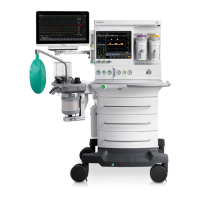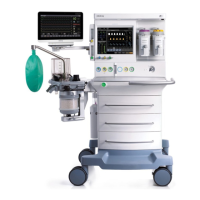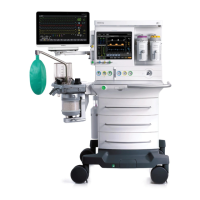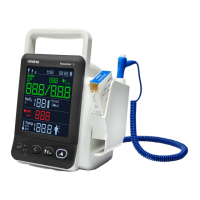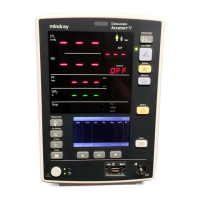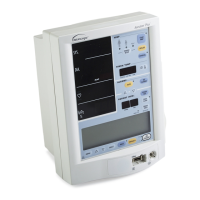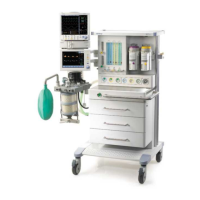Operator’s Manual of Anesthesia System 5 - 15
Preoperative Tests Alarm Test
5. Set the FiO
2
low alarm limit back to a value lower than the measured O
2
value and make sure
that the alarm cancels.
6. Install the O
2
sensor back to the breathing system.
7. Select the Alarms soft key and then the Limits tab. Set the FiO
2
high alarm limit to 50%.
8. Connect the manual bag to the manual bag port. Press the [O
2
Flush] button to inflate the
manual bag. Ensure that the sensor measures 90% O
2
at least.
9. Ensure that a [FiO
2
Too High] alarm occurs.
10. Set the FiO
2
high alarm limit to 100% and make sure that the alarm cancels.
5.12.3 Minute Volume (MV) Too Low Alarm Test
1. Connect the test lung or manual bag to the Y-piece of the breathing circuit.
2. Set the ventilation switch to the Auto position.
3. Set the ventilator controls as follows:
•Ventilation mode: VCV
• Vt: 500 mL
• RR: 12 bpm
• I:E: 1:2
•Tpause: 10%
•PEEP: 0 cmH
2
O
• Plimit: 30 cmH
2
O
4. On the Main Screen, select the [Alarms] soft key > [Limits] tab. Set the MV low alarm limit
to 15.0 L/min.
5. Ensure that a [MV Too Low] alarm occurs after approximately 60 seconds.
6. Select the [Alarms] soft key > [Limits] tab. Set the MV low alarm limit back to a value lower than
the measured MV value and ensure that the alarm cancels.
5.12.4 Apnea Alarm Test
1. Connect the manual bag to the manual bag port.
2. Set the ventilation switch to the Manual position.
3. Turn the APL valve control to set the APL valve to 10 cmH
2
O position.
4. Push the [O
2
Flush] button to inflate the bag. Squeeze the manual bag to make sure that a
complete breathing cycle is displayed on the screen.
5. Stop squeezing the manual bag and wait for more than 30 seconds to ensure that the [Apnea]
alarm occurs.
6. Inflate and squeeze the manual bag to ensure that the apnea alarm cancels.
